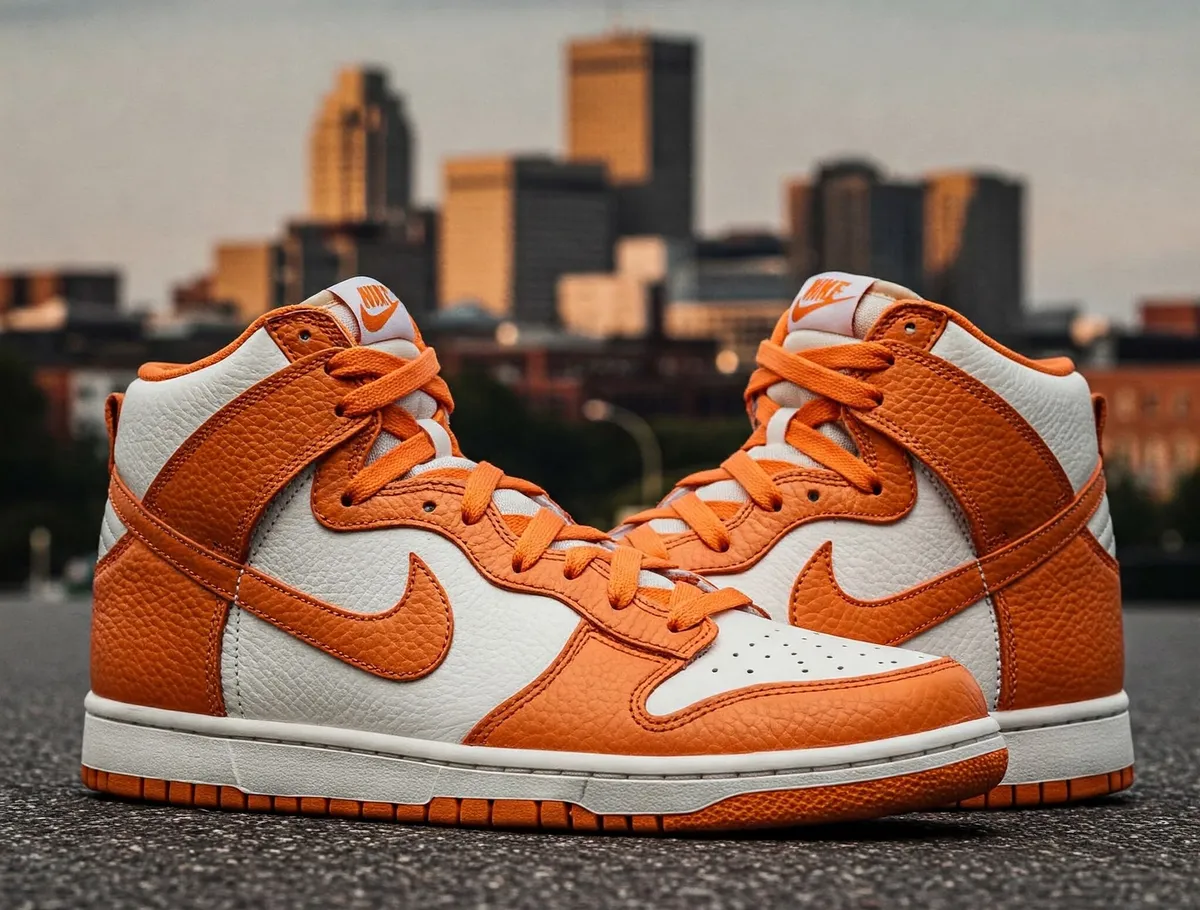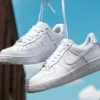Introduction: The Sneaker That Never Fades
Picture a sneaker that started on basketball courts, won over skaters, and now struts down city streets as an urban fashion icon. That’s the Nike Dunk—a shoe that effortlessly transcends generations, trends, and styles. Since its debut in 1985, the Dunk isn’t just a Nike product; it’s a living piece of history, layered with culture, innovation, and passion. What makes it so special? How has it stayed relevant for nearly four decades in a world where everything seems disposable?
In this article, we’ll dive into the journey of the Nike Dunk, exploring how it became a timeless symbol. It’s not just about the design or the brand behind it—it’s about the stories it carries: from college campuses to celebrity feet, through legendary collaborations and moments that shaped sneaker culture. Get ready for a laid-back ride full of fun facts and details that show why the Dunk is so much more than just a pair of sneakers. Let’s go!
The Birth of an Icon in 1985
It all started in 1985, a time when Nike was still carving out its place in the sports world. The Air Jordan 1, launched the same year, was already stealing the spotlight on NBA courts, but Nike had another plan up its sleeve: dominating college basketball. Enter Peter Moore, the legendary former Nike creative director and designer behind the iconic Jordan 1, tasked with creating something fresh. The result was the Nike Dunk, designed by Moore as an evolution of the Nike Air Force 1, released three years earlier in 1982. With similarities to the Air Jordan 1 and Nike Terminator, the Dunk’s upper featured subtle tweaks, making it a kind of middle ground between those two familiar silhouettes.
Though often mistakenly described as a precursor to the Jordan 1, the Dunk actually arrived shortly after the Air Jordan 1—which was crafted to convince Michael Jordan to sign with the swoosh brand. The Dunk debuted with the “Be True to Your School” campaign, featuring vibrant colors inspired by American universities like Kentucky, Syracuse, and Michigan. The idea was to connect fans with their favorite teams, and Nike nailed it. The sneaker quickly became a hit on campuses, with students proudly rocking their school’s colors.
The Dunk wasn’t exactly groundbreaking in terms of tech. It borrowed elements from the Air Force 1 and Jordan 1 but had a charm all its own: a high-top silhouette for support, a clean design, and a versatility that soon caught attention. The name “Dunk,” inspired by the iconic basketball slam dunk, gave it a dose of personality. And though no one knew it at the time, this was just the first chapter of a story that would span decades. Created by Peter Moore, the same genius behind the Jordan 1, the Nike Dunk was born with a winning DNA, ready to become much more than a college basketball sneaker.
From Campuses to Streets: The First Transition
The Dunk’s early success on college courts was undeniable, but the real magic happened when it broke free from sports. In the ‘80s, sneaker culture was just starting to take shape, but there were already hints that sneakers could be more than athletic gear. With its clean design and bold color palette, the Dunk started popping up off the court, on the feet of young people eager to express their style and identity.
Nike saw this shift and, instead of resisting, leaned into it. Low-top versions began to appear, making the sneaker even more practical for everyday wear. It wasn’t just about basketball anymore—it was about attitude. This transition was pivotal for what came next. While the Air Jordan 1 became the NBA’s king with Michael Jordan, the Dunk found its place as a street favorite, a shoe that spoke to both athletes and those just looking for something cool to pair with jeans.
It’s worth noting that back then, Nike didn’t have the marketing juggernaut it has today. The Dunk’s growth was organic, almost like word-of-mouth among communities that saw its potential beyond sports. This was the first sign that the sneaker had something special: the ability to adapt to new contexts without losing its core.
The Skate Revolution and the Birth of the SB Dunk
If the ‘80s planted the seeds for the Dunk’s timelessness, the 2000s were when it exploded as a cultural phenomenon, and skateboarding was the driving force. By 2000, skate culture was booming, and Nike was desperate to break into it. But skaters weren’t exactly fans—they saw Nike as a symbol of corporate America, far from the authenticity of their subculture. Plus, Nike’s skate shoes at the time were out of touch and didn’t meet the community’s standards.
That’s when Nike tapped Sandy Bodecker to revamp its skate division, kicking off the greatest era in the Nike Dunk’s history. Sandy noticed something others had overlooked: Nike already had a quiet presence in the skate scene. In the late ‘90s, skaters were snapping up discounted Air Jordan 1s, which were durable, offered great board feel, and gripped skateboards well, making them a go-to choice. Inspired by this, Sandy realized Nike SB didn’t need to reinvent the wheel—just refine what already worked.
Digging through Nike’s archives, he chose to revive the long-forgotten Nike Dunk. In 2002, the Nike SB Dunk was born—the “SB” standing for “Skateboarding.” It was a souped-up version of the original, redesigned specifically for skating. The sneaker became a low-top model with a padded, thicker tongue, a grippier sole, and extra cushioning to withstand the wear and tear of skate tricks. The result was a classic tailored to skaters’ needs, blending style and function.
But making a great sneaker wasn’t enough. Skaters rejected mass-produced products, and that’s where Nike SB’s marketing strategy shone. The brand opted to produce all colorways (CW) in very limited quantities, distributing them exclusively through select skate shops. This scarcity created instant hype, finally drawing attention to the brand and the model. What truly cemented the SB Dunk as an icon, though, was the collaboration strategy. Nike began partnering with famous skaters, streetwear brands, and even local shops, creating special editions that became true collector’s items.
A standout example was the “Pigeon” Dunk, launched in 2005 with Staple Design. Featuring a simple pigeon graphic, the sneaker sparked massive lines in New York and even caused street chaos, showing the power of limited editions.
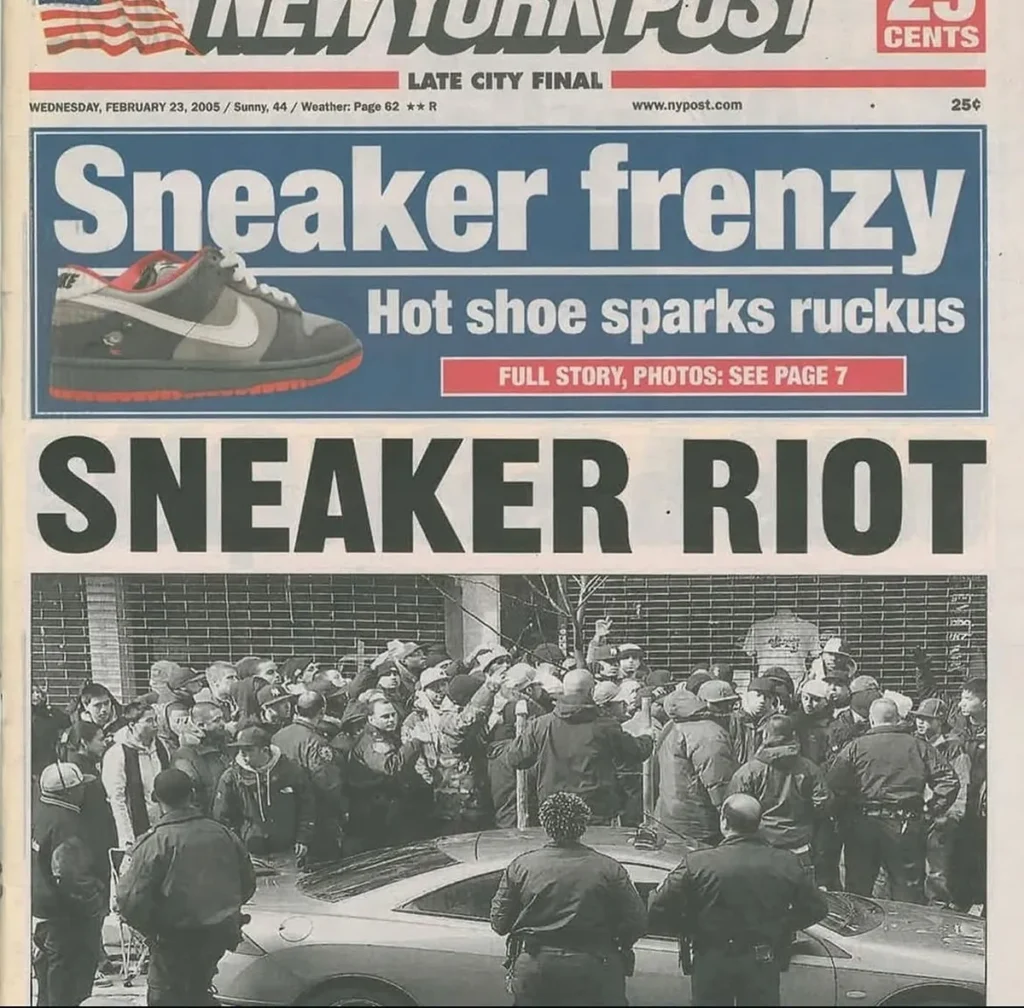
Another milestone came in 2002 with the Supreme collaboration, resulting in the “Black Cement” SB Dunk, inspired by the Air Jordan 3. These releases transcended mere footwear; they were cultural events that fueled the budding sneaker culture, establishing the Dunk as a symbol of the movement.
THE BOXES THAT DEFINED ERAS IN NIKE DUNK SB HISTORY

If you’re a fan or have researched Nike Dunk SBs, you’ve likely come across terms like “Orange Box era” or “Blue Box era.” These refer to different phases of the Nike SB line, marked by the colors of the boxes the sneakers came in. Since the line’s launch, each box color has become a recognizable symbol of a specific era, to the point that sneakerheads can often pinpoint a release year just by looking at the packaging.
In the first year of the line, Nike SB sneakers came in the traditional orange-and-brown Nike box. Over time, new box colors emerged, each representing a distinct period in the brand’s evolution. Check out the eras and their respective dates below:
- Orange Box: March 2002 to December 2002
The first box of the SB line, introduced in the debut year, featuring Nike’s classic orange-and-brown design. - Silver Box: January 2003 to September 2004
A shift to silver, marking Nike SB’s consolidation in the market. - Pink Box: September 2004 to December 2005
The vibrant pink brought new energy, coinciding with the growing hype for limited editions. - Black Box: February 2006 to September 2007
The black box reflected a bolder, more mature phase for the line. - Gold Box: October 2007 to March 2009
The gold symbolized a period of prestige and standout collaborations. - Blue Box: April 2009 to June 2012
The blue marked an era of innovation and expanding SB’s influence. - Taped Box: July 2012 to November 2013
With a unique design, this box signaled a shift in visual identity. - Teal Box: December 2013 to December 2019
The teal hue dominated for years, accompanying the line’s modern evolution. - Striped Box: January 2020 to present (March 2025)
The striped box reflects a contemporary style and the ongoing SB legacy.
These boxes aren’t just packaging; they tell the story of the Nike Dunk SB and its connection to sneaker culture, remaining a nostalgic and valuable detail for collectors to this day.
Remembering Sandy Bodecker
Sadly, Sandy Bodecker passed away in October 2018, but his legacy lives on in everything Nike SB does. Nike released a tribute video honoring the man who put the “SB” in Nike SB, recognizing his visionary genius. Under his leadership, the Nike SB Dunk not only won over skaters but became a timeless icon, proving that with authenticity and strategy, a forgotten sneaker could become a global phenomenon.
The Role of Collaborations in Its Timelessness
If there’s one thing keeping the Nike Dunk alive and relevant today, it’s the collaborations. From the early SB Dunks, Nike realized that partnerships with artists, brands, and personalities could add new layers of meaning to the sneaker. And it became a tradition. From Travis Scott to Virgil Abloh, through Ben & Jerry’s and Off-White, the Dunk has had so many versions it’s nearly impossible to list them all.
Take the Travis Scott x Nike SB Dunk Low, released in 2020. With details like paisley patterns that wear away to reveal an elephant print, it wasn’t just a sneaker—it was an experience. Or the Off-White x Nike Dunk Low, signed by Virgil Abloh, which brought a high-fashion edge with extra laces and a deconstructed aesthetic. These collaborations don’t just refresh the Dunk; they tie it to specific moments in pop culture, ensuring it never feels stuck in the past.
It’s not just the big names that matter. Regional editions, like Dunks made with skate shops in Japan or local artists, show how the sneaker can be both global and hyper-local. According to Hypebeast, limited Dunk collaborations drive millions in the resale market, with pairs fetching up to $1,500 Hypebeast. This proves the Dunk isn’t just a shoe—it’s a cultural investment.
The Resurgence in the 2010s and 2020s
After a period of ups and downs, the Dunk came back strong in the last decade. In the 2010s, nostalgia started gaining traction, and Nike rode that wave. Re-releases of classic colorways like the “Panda” (black and white) exploded in popularity, while new collaborations kept the model on sneakerheads’ radars. But 2020 marked a new peak, fueled by a mix of factors: the influence of social media like TikTok, the streetwear boom, and the return of ‘90s aesthetics.
Celebrities like Kylie Jenner and Justin Bieber were spotted in Dunks, while Virgil Abloh, before his passing in 2021, elevated the sneaker to luxury status with his Off-White designs. Nike played it smart by ramping up production of “basic” models like the Dunk Low, making it more accessible without losing its appeal. Suddenly, the Dunk was everywhere: on the streets, on runways, and on the feet of people who’d never heard of its basketball or skate roots.
This resurgence wasn’t accidental. A StockX study showed that in 2020, the Nike Dunk was one of the most traded models on the resale market, rivaling even Air Jordans on StockX. The secret? It bridges the past and present like few others can.
A Design That Never Ages
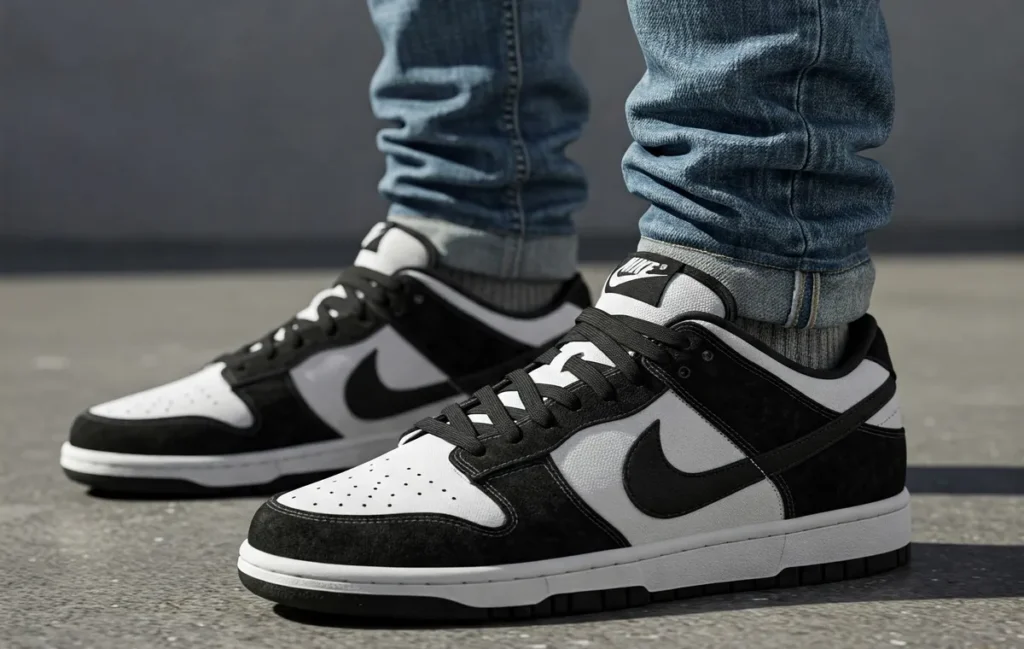
If there’s a secret to the Nike Dunk’s longevity, it’s the design. Simple yet striking, the Dunk’s silhouette is like a blank canvas that welcomes any color, pattern, or interpretation. The high or low top, the side swoosh, the rubber sole, and the foot-hugging shape are elements that never seem to go out of style. But why does it work so well?
First, the Dunk has an aesthetic that balances classic and contemporary. Born in the ‘80s—a decade that still inspires trends—it carries a retro vibe without feeling dated. According to Complex, the Dunk’s simplicity is what allows it to reinvent itself without losing its identity Complex. While other sneakers chase futuristic tech or over-the-top designs, the Dunk sticks to a solid foundation that appeals to both purists and fashionistas.
Another factor is versatility. Want to wear it with an oversized hoodie? It works. With tailored pants? That works too. This flexibility makes it a wardrobe staple, something few shoes achieve. And Nike knows it: by re-releasing basic colorways like the “Panda” or creating limited editions packed with details, the brand keeps the model fresh yet true to its roots. It’s a rare case of a design that evolves without betraying itself.
Cultural Impact Beyond Courts and Skateparks
The Nike Dunk isn’t just a sneaker; it’s a piece of pop culture. It’s been part of moments that defined generations, from ‘80s college games to 2000s rap music videos. But its impact goes beyond what feet can carry—it reflects social, economic, and even technological shifts.
In the 2000s, the SB Dunk boom coincided with the rise of the internet and online subcultures. Forums like NikeTalk and resale sites like eBay turned the sneaker into a status symbol, something you wore to show you were part of an exclusive club. By the 2020s, TikTok and Instagram took this to another level. Unboxing videos and style tutorials went viral, while influencers showed how to pair Dunks with everyday looks. Suddenly, it wasn’t just for skaters or sneakerheads—it was for everyone.
The Dunk also mirrors the rise of streetwear as a dominant force in fashion. Brands like Supreme, Stussy, and Off-White used the model as a canvas for creations blending high fashion with street culture, a movement Vogue called “the democratization of luxury” Vogue. And let’s not forget the music connection: artists like Kanye West and Travis Scott, who have their own Nike sneakers, kept the Dunk in the spotlight, whether through direct collaborations or their influence on sneaker hype.
Authenticity Challenges in Today’s Market
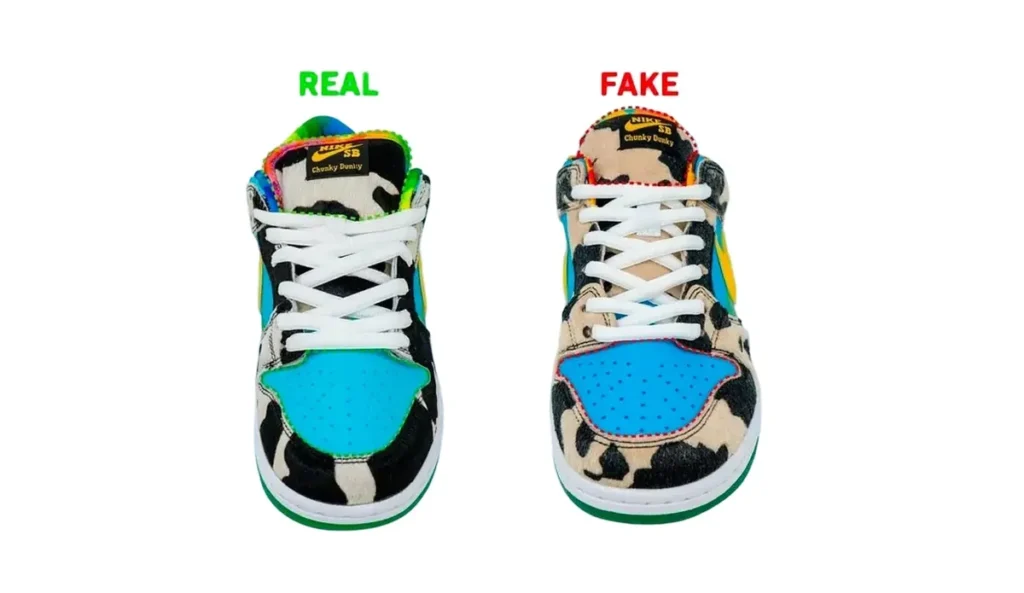
With so much popularity comes a dark side: counterfeits. The Nike Dunk resale market has exploded in recent years, with platforms like StockX and GOAT recording sales of rare pairs for thousands of dollars. But where there’s demand, there are opportunists. High-quality replicas have flooded the market, and even the most vigilant fans sometimes get duped.
Nike tries to combat this with tech like the Nike SNKRS app, which controls releases and hinders bots, but the problem persists. According to Forbes, the counterfeit sneaker market is worth billions annually, and the Dunk is a prime target due to its status Forbes. For consumers, the advice is simple: buy from trusted sources like official stores or verified resellers, and watch for details like stitching and materials.
This challenge, though, also underscores the Dunk’s strength. If it weren’t so coveted, there wouldn’t be so many fakes. It’s a trial by fire that only true icons face, and the Dunk stands tall, proving its authenticity goes beyond the physical—it’s in the history it carries.
Why the Dunk Never Dies
Here’s the heart of it: what makes the Nike Dunk timeless? It’s not just the design, the collaborations, or the hype. It’s its ability to tell stories. Every pair, whether a 1985 original or a 2020 SB, carries a piece of its wearer—the student on the court, the skater on the street, the collector in line. It’s a mirror of the eras it’s lived through and a magnet for new generations.
Nike deserves credit for playing the game well. Nostalgic re-releases keep longtime fans engaged, while bold collaborations draw in younger crowds. Best of all, the Dunk doesn’t rely on a single narrative. It’s basketball, skate, fashion, art—all at once. That multiplicity keeps it alive, even in a world where trends come and go in months.
Conclusion: Our Sneaker, Our Story
Those of us who’ve followed the Nike Dunk’s journey know it’s more than just a shoe on the shelf. It’s a testament to how culture can turn simple objects into powerful symbols. From college campuses to skater-filled streets, from chaotic launches to high-fashion runways, the Dunk has proven that timelessness isn’t just about surviving time—it’s about dancing with it.
Looking back, it’s clear the Dunk’s success wasn’t planned from the start. It was born as a functional sneaker but grew because of the people who embraced it and a Nike that listened. Today, it’s ours: a piece of history we carry on our feet, a reminder that what’s good doesn’t need to shout to be eternal. So, what’s your favorite Dunk?
FAQ About the Nike Dunk
What is the Nike Dunk?
The Nike Dunk is a sneaker launched in 1985, originally designed for college basketball, that evolved into an icon of fashion and sneaker culture over the years.
When was the Nike Dunk released?
The original model debuted in 1985 with the “Be True to Your School” campaign, featuring colors of American universities.
What’s the difference between Dunk and SB Dunk?
The SB Dunk, launched in 2002, is a skateboarding-adapted version with a grippier sole and padded tongue, while the original Dunk focuses on basketball and casual use.
Why is the Nike Dunk so popular?
Its popularity stems from its versatile design, limited-edition collaborations, and ties to subcultures like skate and streetwear, plus ‘80s and ‘90s nostalgia.
What are the most famous Dunk collaborations?
Standouts include the “Pigeon” with Staple Design, the Supreme “Black Cement,” and the Travis Scott x Nike SB Dunk Low, among others.
Is the Nike Dunk comfortable for everyday wear?
Yes, its simple construction and cushioned sole make it great for casual use, especially in low-top versions.
How can I spot a fake Nike Dunk?
Look for uneven stitching or low-quality materials, and buy from trusted sources like Nike SNKRS or verified resellers.
What’s the average price of a Nike Dunk?
Basic models range from $100 to $150, but limited editions can fetch thousands in the resale market.
Is the Nike Dunk still used in basketball?
Today, it’s more a fashion item than a sports shoe, but its basketball roots still inspire many fans.
Is it worth investing in a Nike Dunk?
Yes, especially rare editions that tend to appreciate over time, but its real value lies in its style and history.
